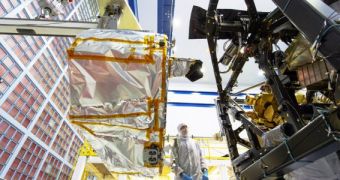Engineering teams at the NASA Goddard Space Flight Center (GSFC) in Greenbelt, Maryland, announce the successful integration of all four main science instruments on NASA's upcoming James Webb Space Telescope (JWST) into the Integrated Science Instrument Module (ISIM). This marks a critically-important step in the process of assembling the United States' future flagship telescope.
The ISIM is one of the most important and complex components of the space observatory. Its main components are the Near Infrared Camera (NIRCam), the Near-Infrared Spectrograph (NIRSpec), the Mid Infrared Instrument (MIRI), and the Near Infrared Imager and Slitless Spectrograph (NIRISS). NIRSpec was the last addition to the ISIM; engineers finished installing it in late March.
Getting the four instruments to fit inside the ISIM was no easy task. James Webb is extremely large, but the amount of space available on its frame is minimal. The devices had to fit in an intricate arrangement with extremely narrow wiggle room. Despite the complexity of this operation, the Module has been completed and can now be integrated with the rest of the spacecraft bus.
The JWST is being developed to replace the aging Hubble Space Telescope, which was launched back in 1991. James Webb will probably be launched into space aboard an Ariane V heavy-lift delivery system provided by European contractor Arianespace, from the European Space Agency's (ESA) Kourou Spaceport in French Guiana, South America.

 14 DAY TRIAL //
14 DAY TRIAL // 